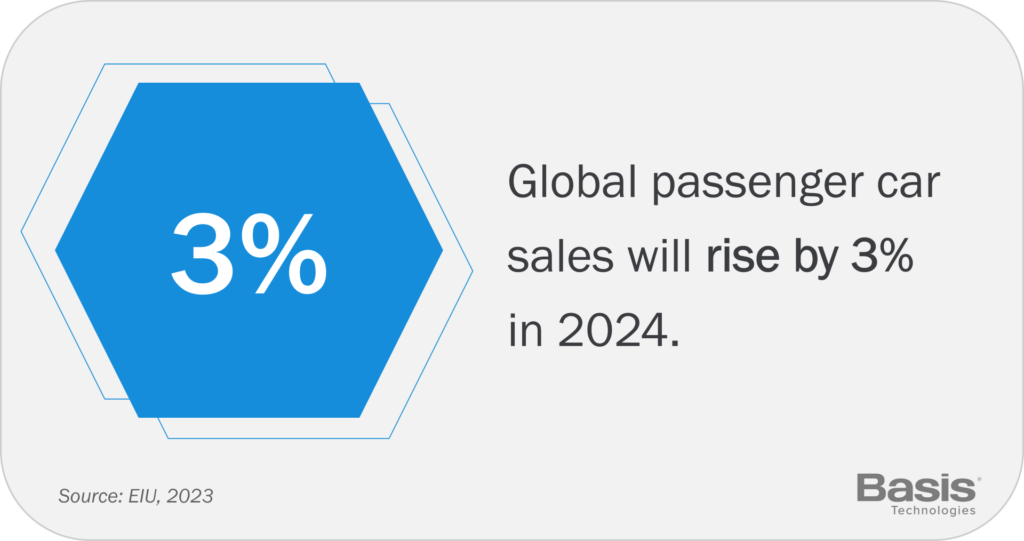
Massive changes are taking place in both the automotive and the marketing industries, and automotive marketers are caught right in the middle.
On the automotive side, both the unprecedented supply chain disruptions and semiconductor shortages that began during COVID-19 continue on to today, with many industry analysts predicting that inventory levels will never return to what they were pre-pandemic. In 2024, EIU forecasts that the sector will also be weighed down by slow consumer spending, high interest rates driven by stubborn inflation, and big bets on electric vehicles. On top of all that, in the longer-term, the resolution of the United Auto Workers (UAW) strike will likely result in UAW brands raising their prices to account for increasing employee salaries—and other auto brands may follow suit as part of a trickle-down effect.

And on the marketing side? Nothing major: just signal loss driven by the continued deprecation of third-party cookies, an uptick in digital advertising regulation and scrutiny, and massive technological advances that stand to redefine the landscape... you know, nothing much.
Amidst all these challenges, automotive marketers must prioritize strategies and tools that allow them to make the absolute most of their advertising dollars and their people. To that end, here are three trends that will be top of mind for future-forward auto marketers in 2024:
We all know that prioritizing the collection and extension of first-party data is a must as we move towards a privacy-friendly future. As marketers in the automotive industry move in that direction, leading brands and dealers will begin to consolidate their databases and execute a coordinated first-party data strategy to reduce the duplication of efforts and to make the most of all the data available to them.
Most automotive brands have had CDPs and data lakes in place for a long time. Now, those tools are being adopted within the dealership ecosystem, and with more sophisticated audience segmentation capabilities, dealers will be able to share more relevant audiences with brands and to deploy those segments on their own. Most dealerships have significantly more data than brands just by virtue of the nature of their business, so there’s a huge opportunity to share that with brands. This consolidation and coordination of data between brands and dealers will reduce duplication of tactics and strategies and allow both parties to make the most of all the first-party data available to them.
Automation is key for digital marketers who want to make the most of first-party data for personalization at scale. After all: If first-party data constitutes the wheels that enable marketers to connect with consumers, then automation is the engine that allows marketers to use that data effectively. (Sound familiar?)
But that isn’t the only use case for advertising automation. Automation can help automotive marketers build and deploy omnichannel campaigns more quickly, automatically optimizing pace and spend across all channels and moving budget from low performing channels to high performing channels—saving advertisers both time and money. For automotive marketers, the efficiency offered by these tools will be a game-changer for overcoming challenges like slow consumer spending, high interest rates, and signal loss. These technologies are developing quickly, and there’s a benefit to getting your foot in the door early so that you're primed for taking advantage of all the innovations coming down the line.
Artificial intelligence is another area that’s innovating quickly, and savvy automotive marketers will be keeping an eye on the space to ensure they’re tapping into all the ways AI can work for them. There are a host of ways marketers can leverage AI, such as using generative AI tools and DCO to produce marketing content and deploy targeted one-to-one email communications at scale. AI can also assist in personalizing and automating parts of customer communication via websites and call centers. Like automation, artificial intelligence tools can provide both time savings and cost-efficiencies, giving automotive marketers a competitive edge in a particularly competitive moment for the industry.
2024 is a year for automotive marketers to step on the gas. Marketing teams can get ahead by prioritizing the collection and extension of first-party data and coordinating that data with their brand/dealer counterparts; and embracing automation and AI tools that can reduce manual labor and save time as well as money. The road to automotive marketing success is clear—why wait?
—
Hungry for more 2024 trends? Check out our 2024 Trends Report for everything digital marketers need to know for next year.